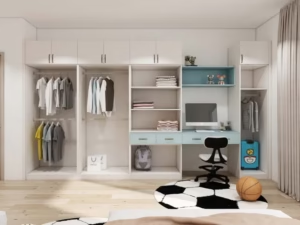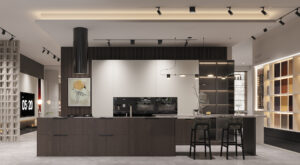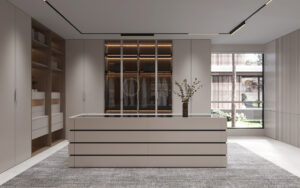Styles and Colors of Cabinet Doors
The type of door you pick for your kitchen cabinets plays a big part in the room’s style and how helpful your cabinets are. We will talk about three common types of cabinet doors: slab, raised panel, and recessed panel. We’ll also discuss the good and bad points of putting handles or knobs on each type.
Learn more: Cabinet And Door Material
Slab Cabinet Doors
These doors have a simple, flat look. They are usually one solid piece without any frames or panels.
- Pros: Putting handles or knobs on these doors can give them a more stylish look or add a splash of color. Handles also make it easier to open the doors without leaving marks or fingerprints.
- Cons: Handles or knobs can break the smooth look of slab doors. They also cost more and take extra work to put on.

Raised Panel Cabinet Doors
Raised panel doors feature a center panel that stands out above the rest of the door. They have a contoured edge that fits into the door frame, often seen in kitchens with a classic or traditional style.
- Pros: Handles or knobs can complement the intricate design of these doors, adding to their traditional charm. They also simplify opening and closing the doors.
- Cons: If the handles or knobs don’t match the door’s style, they can reduce its visual appeal. Like slab doors, adding hardware increases the cost and involves more work for installation.

Types of Cabinet Hardware
Cabinet hardware is a small part of your kitchen’s decor, but it has a significant effect on the look and function of your space. Here are some common and special kinds of cabinet hardware:
Knobs
These small, often round pieces attach to cabinet doors or drawers with one screw. They are available in many styles and materials, from simple wooden ones to fancy glass or metal.
Pulls
Pulls are bigger than knobs, and you can hold them with your whole hand. They attach with two screws and work for both doors and drawers. There are many styles, from modern to traditional.
- Cup Pulls: Also known as bin pulls, these are shaped like a half-circle for easy grabbing. They’re often used on drawers and can give a vintage or rustic look.
- Bar Pulls: Long and straight; these pulls are mainly used on drawers. They have a modern, clean look and come in different lengths and finishes.
- Flat Pulls: Also called tab pulls, these are level with the cabinet surface. They give a minimalist, modern style and are common in contemporary kitchens.

Cremone Bolts
Decorative hardware often found on tall cabinets or armoires. They use a long rod, moved by turning a knob or lever, to lock the door.
Latches
This hardware secures doors by catching when closed. They add a quaint, old-fashioned feel.
Locks
Helpful in securing essential items, locks are suitable for office cabinets or those storing liquor or cleaning products.
Metals and Finishes of Cabinet Hardware
The choice of metals and finishes for cabinet hardware depends on your kitchen’s style, but here are some guidelines:
- Stainless Steel: Great for modern or industrial kitchens. It’s strong, easy to clean, and goes well with stainless steel appliances.
- Brass: Comes in a range from shiny to aged and antique-like. Brass is flexible and can add elegance to any kitchen.
- Bronze: Often has a warm, rich color, bringing depth and character to cabinets. It’s a favorite in traditional or rustic kitchens.
- Nickel: Available in polished (shiny and reflective) and brushed (more muted and matte) finishes.
- Black Iron: Adds a bold, dramatic look. Commonly used in farmhouse or industrial-style kitchens.
How to Install Cabinet Hardware
Step 1: Choose the Correct Screws

Before starting, ensure you have the correct size screws for your cabinet hardware. Often, the hardware comes with 1-inch screws suitable for doors, but you might need longer screws for drawers. Measure the thickness of both your cabinet doors and drawer fronts, including the drawer box, to find the right screw size.
If the screws are too long or too short, you can get the right ones at any home improvement store.
- For cabinet doors, which are usually 3/4 inch thick, screws that are 1 to 1 1/4 inches long are typically needed. This size allows the screw to secure the hardware without poking through the inside of the cabinet.
- For drawer fronts, they can be thicker, especially if there’s a separate box attached. A typical drawer front might be 3/4 inch, with the box adding another 1/2 to 3/4 inch. For these, you might need screws that are 1 1/2 to 2 inches long.
Remember, these are general guidelines. The exact size of screws you need can vary based on your specific hardware and cabinets. It’s best to measure before buying screws.
Although most cabinet hardware includes screws, they may not be the correct size for your cabinets, especially if they are thicker than average. In this case, you’ll need to buy additional screws of the appropriate length.
Step 2: Mark Locations for New Cabinet Handles

If existing screw holes are suitable, insert and tighten the new screws for your handles. For new screw holes, follow these steps to measure and mark their locations:
- On cabinet doors with stiles (frames), position pulls 2 to 3 inches from the bottom edge, centered on the stile’s width.
- For slab doors without stiles, place pulls 2 to 3 inches up from the bottom edge and the same distance from the side edge.
- Use a pencil to mark these measurements.
- For installing a knob, drill at the marked spot.
- For handles with two screws, the mark will be the handle’s midpoint. Measure the distance between the handle’s screws, then halve this distance to find the top and bottom screw hole locations from your center mark.
Tips:
- Make a template out of cardboard to streamline the process for multiple doors.
- Use the cardboard corner as the door’s corner and mark the screw hole locations on it.
- Align the template with the cabinet door and use a nail to start the screw holes.
Step 3: Drill the Cabinet Doors

When drilling the doors:
- Open the Door: Keep the door open during drilling to avoid drilling the wrong side or into the cabinet frame.
- First Holes and Template Use: After drilling the initial holes, determine which template holes align best. You should drill a new hole in your template. For subsequent doors, mark the holes on the door using the template and a pencil.
- Avoid Drilling Through the Template: Drill directly onto the door, not through the template. Drilling through the template can enlarge the holes over time, leading to inaccurate measurements.
Tips:
- Most cabinet screws require a 3/16-inch diameter hole, so use a power drill with a 3/16-inch twist bit to make the screw holes. The instructions from the cabinet pull manufacturer will also tell you what size drill bit to use. If you’re not sure, drill a test hole in a piece of scrap wood to check if the fastening screws fit.
- Hold the door open with one hand while drilling, or keep it open with a towel to avoid drilling into the cabinet frame.
- Drill through the door at the places you marked for the screw holes.
Step 4: Drill Cabinet Drawers

Drilling cabinet drawers is a bit more challenging than doors, but it’s manageable. Here’s how to do it:
- Measure and Mark the Center Vertically: Measure the height of the drawer front and divide it by two to find the vertical center. Mark this point lightly with a pencil. Be gentle to avoid leaving indentations in the wood.
- Mark the Center Horizontally: Next, measure the width of the drawer front and halve it to find the horizontal center. If you’re installing a knob, this center point is where you’ll drill.
- For Pull Handles: If you’re installing a pull handle with two screws, measure equal distances to the left and right of the center mark to ensure the handle is centered. For wider drawers, you might opt for two pulls. In this case, measure equal distances from both sides. Use your template to align the holes after drilling the first set.
Tips:
- Use a Sharp Drill Bit: Always use a new, sharp drill bit and avoid pressing too hard. A dull bit or excessive pressure can blow out the back of the wood, making it look unsightly.
- Cabinet Adjustments: Make any necessary adjustments to your cabinets before drilling. If you drill before adjusting, the hardware might look off-level and be more difficult to correct later.
- Drill Bit Size: Use a drill bit slightly larger than your screw. For standard 8/32″ screws, a 3/16″ drill bit is recommended. This ensures the screw goes in smoothly without stripping or breaking.
- Seek Advice if Unsure: If you need more certainty about any step, ask for help. Cabinet doors and drawers are costly to replace, so it’s worth taking the time to do the job correctly.






